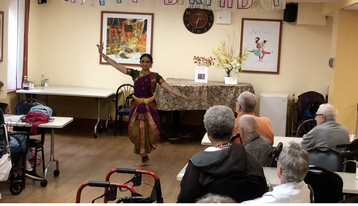 Demonstration at The West Side Federation for Senior and Supportive Housing at W76th street in NYC Demonstration at The West Side Federation for Senior and Supportive Housing at W76th street in NYC Making Bharatanatyam inclusive: the approach One challenge I’ve faced for an audience with no or very little exposure to Bharatanatyam or any Indian art form is its relevance in a Western/current context. Many of the pieces we are taught as part of the traditional repertoire (called “margam”) are related to Indian (Hindu) deities and stories which may be unfamiliar to a modern audience. I have found that there are many solutions to this challenge; what has worked for me is to bring out the universality of Bharatanatyam. There are many, many aspects of Bharatanatyam that are relevant to people all over the world today. As an example, students of Bharatanatyam may be familiar with the movement of stringing flowers to make a necklace for one’s braid, or a garland for an idol. Even though I lived and grew up in India, I never actually put together flowers for this purpose, so the movement was always imaginary to me. However, for Western audiences, I have used similar hand gestures ("mudras") to arrange flowers in a vase. Another motif that could be relevant is that of decoration or adornment. This could be used to use mudras to show setting table for guests, or to garnish a dish to serve friends. Finding ways to connect Bharatanatyam with something happening in the lives of the participants is also uniquely helpful. A few examples that have worked for me are to use specific rhythmic patterns that remind participants in NYC of the cadence of the city’s subway system. The essence of performance comes through when commuters experience a mariachi band or the subway performers. Looking at tourists in NYC absorbed in their maps and selfies while neglecting to take in this marvelous city also evokes the emotion ("rasa") of laughter (hasya). Many times, people may find movement not intuitive and a bit uncomfortable and shy; on these occasions, finding ways for people to engage that are other than movement may be beneficial. The avenues that have worked for me are music and painting. For example, I was able to bring this painting to the session to talk about the emotion of love (sringara).
0 Comments
Leave a Reply. |
AuthorMy name is Sloka. I am a neuroscientist and dancer; you can find more about me here. Archives
June 2024
|